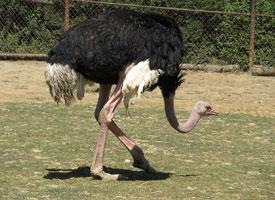
Greutăți și măsuri
| Înălțime la greabăn | de la 200 la 275 cm |
|---|---|
| Greutate | de la 90 la 130 kg |
| Lungimea anvergurii aripilor | 200 cm |
Date biologice
| Durata de viață | de la 30 la 70 ani |
|---|
Descrierea animalului
The Common Ostrich (Struthio camelus), an emblem of the avian world's grandeur, stands as a marvel of evolutionary adaptation and sheer physical prowess. This magnificent bird, native to the vast savannas and arid regions of Africa, holds the title of the world's largest and heaviest living bird. With a towering height that can reach up to 9 feet (about 2.7 meters) and a weight that can soar up to 320 pounds (approximately 145 kilograms), the ostrich is an imposing figure on the landscape.Distinctive for its long, powerful legs and large, flightless body, the ostrich is designed for terrestrial life. Its legs, equipped with two strong toes, are not only adapted for running at breathtaking speeds of up to 45 miles per hour (about 72 kilometers per hour) but also serve as formidable weapons against predators. The ostrich's ability to cover 10 to 16 feet (about 3 to 5 meters) in a single stride is a testament to its remarkable speed and agility.
The common ostrich sports a sparse covering of feathers, with males typically showcasing a striking contrast of black and white plumage, while females and young ostriches wear a more subdued brown. The male's bold coloring plays a role in mating rituals and displays, while the female's camouflaged tones offer protection in the wild. Ostriches possess small heads and large, expressive eyes, each about 2 inches (5 centimeters) in diameter, granting them excellent vision to spot potential threats from afar.
Unlike other birds, ostriches have a unique physiological makeup with a highly efficient respiratory system and a body temperature that fluctuates to cope with extreme environmental conditions. They are omnivores, feeding on a diet that includes seeds, shrubs, insects, and other small creatures, demonstrating their adaptability in diverse habitats.
Social creatures by nature, ostriches often gather in flocks that can number from a few individuals to over a hundred, especially during the breeding season. These flocks are usually led by a dominant male, who mates with the primary female of the group, though he may also mate with other females. The communal nests, which are essentially large pits in the ground, may contain eggs from several females, with the dominant female's eggs placed in the center. Both males and females take turns incubating the eggs, showcasing a unique aspect of ostrich parental care.
Despite their formidable size and strength, ostriches face threats from human activities such as hunting for their meat, feathers, and skin, which is highly prized in the fashion industry. Additionally, habitat loss and fragmentation pose significant challenges to their populations. Conservation efforts are underway in various regions to ensure the survival of these remarkable birds, emphasizing the importance of sustainable practices and habitat protection.
In summary, the Common Ostrich is a symbol of the wild's untamed beauty and resilience. Its unique adaptations and fascinating behaviors make it a subject of admiration and curiosity, underscoring the richness of our planet's biodiversity and the critical need to preserve it for future generations.
Fotografii noi cu animale
Top 10 animale
- Dolphin gull (Leucophaeus scoresbii)
- Diana monkey (Cercopithecus diana)
- Moustached guenon (Cercopithecus cephus)
- Galápagos tortoise (Geochelone nigra complex)
- Stone loach (Barbatula barbatula)
- Japanese macaque (Macaca fuscata)
- Greek tortoise (Testudo graeca)
- Russian tortoise (Testudo horsfieldii)
- Common flying dragon (Draco volans)
- Galápagos penguin (Spheniscus mendiculus)